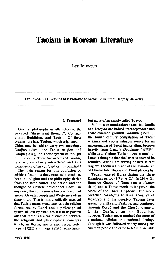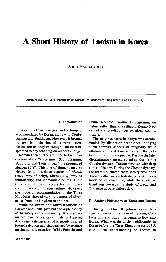




Preview text:
big trends DOI:10.1145/3587264
BY JI-HOON KIM, SUNGYEOB YOO, AND JOO-YOUNG KIM South Korea’s Nationwide Effort for AI Semiconductor Industry
AS GLOBAL COMPETITION in the semiconductor industry has
intensified with trade conflicts and semiconductor
with the paradigm shift in comput-ing.
shortages, major countries worldwide have started to work South Korea aims to become a
comprehensive semiconductor power-
on their government policy and investment plan to win
house from this colossal opportunity. In
technological hegemony. South Korea’s semiconductor
this article, we report recent nation-wide
industry, which makes up almost 20% of the nation’s gross efforts taking place in South Korea to
challenge the emerging AI semiconductor
domestic product (GDP), is heavily concentrated on the
industry. We organize these efforts in
memory semiconductor sector.5 It dominates the global
four sections (govern-ment, major
companies, fabless startups, and
memory semiconductor market with a 56.9% share but has
academia), while Figure 1 overviews the
little influence on the other sectors of the industry, overall efforts.
The South Korean government’s K-
including logic, analog, and optical discrete, where it has
semiconductor strategy is to build the
less than a 3% market share. To grow the nation’s biggest
world’s best semiconductor supply chain
industry further, South Korea has put a priority on non-
by 2030 with a $450B investment plan.2
Learning from the semiconductor crisis,
memory sectors. The emerging AI chip market is an
the goal is to stabilize and internalize the
especially great opportunity for them, as demand is
semi-conductor supply chain by gather-
ing fabless, foundry, and packaging
expected to increase exponentially
companies in a clustered area called
46 COMMUNICATIONS OF THE ACM | JULY 2023 | VOL. 66 | NO. 7 lOMoARcPSD|396 510 89 big trends
east asia & oceania region
the K-Semiconductor Belt for seam-less
The government also is trying to
experts at all levels (junior colleges,
silicon product manufacturing. The
build a collaborative ecosystem that
undergraduate schools, and gradu-ate
government has also announced nearly
helps once-segmented academia and
schools) by 2030. It also plans to
$260B-worth of tax deduc-tions for
industry work together to make
establish new research centers and
semiconductor facilities and R&D
competitive products for the global
university departments to develop
competent researchers and experts in the
funding,3 in addition to making the
market. It has set up national pro-grams
approval process for the expansion of
to facilitate collaboration between semiconductor field.
semiconductor manufacturing facilities
university labs and startup companies by
Major countries, including the U.S.
faster and more flexible, and subsidizing
funding technology transfer and
and China, also have announced support
up to 50% of the construction cost of the
commercialization. The government
policies for their semicon-ductor
facility’s power infrastructure. The
also is subsidizing startup fabless
industries. The U.S. passed the CHIPS
government pledged to invest in
companies to use the latest EDA tools
Act in 2022, which promis-es 25% tax and semiconductor process
strategically important semicon-ductor
credits and a $52B invest-ment to
sectors, including power, automotive, and technologies.
enhance domestic semi-conductor
AI semiconductors, as part of its long-
Lastly, the government is heavily
manufacturing. China’s “Made in China M
term R&D road-map. With the above
focused on fostering high-quality
2025” initiative an-nounced in 2015 has CO. CK
financial and regulatory support, the
manpower for the semiconductor
aimed to lift the country’s chip O T RS
government set a goal of doubling E
industry. Based on a survey that found
production from less than 10% of demand T T U H
semiconductor production to $245B, with
at least 270,000 persons will be needed
to 70% in 2025, fostering government- S M
an export target of $200B, by 2030.
backed fabless and manufacturing RO
to sustain the industry in 10 years, the F Y R
companies. In contrast, South Korea’s E
government aims to foster 150,000 G A IM more semiconductor plan is more
JULY 2023 | VOL. 66 | NO. 7 | COMMUNICATIONS OF THE ACM 47 lOMoAR cPSD| 39651089
east asia & oceania region big trends
Figure 1. Overview of South Korea’s nationwide efforts for the AI semiconductor industry.
Figure 2. Summary of South Korea’s AI semiconductor products. 48
COMMUNICATIONS OF THE ACM | JULY 2023 | VOL. 66 | NO. 7 lOMoARcPSD|396 510 89 big trends
east asia & oceania region
concentrated and streamlined, em-
and research communities to learn the
phasizing human resource develop-
latest AI technologies and engage with ment overall.
well-educated researchers. For example,
the Samsung Science & Technology Major Companies
Foundation announced grants totaling
South Korea’s chip companies work-ing
$40.12 million to 27 high-profile research
in AI semiconductors can be divided into
projects, bolster-ing collaboration with
two groups: major com-panies leading
academia.4 SK Hynix also launched a
the world’s memory semiconductor
knowledge-shar-ing platform named
market, and newly founded fabless
“Semiconductor Academy,” which
startup companies developing AI
provides online/ offline lectures to Once secretly
accelerators. Figure 2 summarizes their
university students, job seekers, and focusing solely on
major products and activities related to
employees, covering a diverse range of AI semiconductor development.
topics including semi-conductor basics, their own product
devices, and design. Moreover, both development,
Samsung Electronics and SK Hynix,
Samsung and SK Hynix continuously
the world’s leading memory semi-
provide multi-project wafer (MPW) major companies
conductor companies, have launched
services for startup fab-less, design are starting to
investment and employment plans for
houses, and academia. This allows greater
their AI semiconductor and foundry
foundry selection for domestic fabless open up relations
businesses. Samsung Electronics is trying
companies and enables competitive to develop next-generation AI
prototyping of their AI chips with the with the academia
semiconductor products by leveraging its
latest process technologies. Samsung has and research
strengths in mobile chipset design and
announced a massive hiring plan to memory manufacturing. Samsung
employ more than 80,000 people in new communities to
develops its own neural processing units
jobs, as the demand for AI semiconductor learn the latest AI
(NPUs) and integrates them into multiple
prod-ucts continues to increase.
processing platforms, includ-ing the technologies and
Exynos mobile processor and the Exynos engage with well- auto processor series. Fabless Startups
Another notable product develop-ment
Ever since it launched the Ministry of educated
direction is putting AI com-putation logic
SMEs and Startups in 2017, South Ko-rea researchers.
into memories. Both Samsung and SK
has been investing heavily in build-ing a
Hynix are developing intelligent memory
startup ecosystem to pivot from a
chips using in/ near-memory processing
conglomerate-based to a startup-based
technol-ogy, which can mitigate the
industry. With successful supporting
system bandwidth bottleneck of
programs such as K-Unicorn and Tech
conventional von Neumann architecture.
Incubator Program for Startups (TIPS),
Samsung released the HBM-PIM, which
South Korea has become a good place for
incor-porates the AI processing function
startups, surpassing $6.4B in ven-ture
into the HBM2 memory stack, and the
capital funding in 2021.6 Benefit-ing from
AXDIMM, which adds an AI engine in-
this environmental change, more than 10
side the buffer chip of the traditional
fabless startups targeting AI hardware
DIMM form factor. The company also
accelerators have been founded in South
developed SmartSSD, which integrates
Korea in the past five years. Unlike the
Samsung’s solid-state drive (SSD) and
major companies that develop next-
Xilinx’s field-programmable gate array
generation AI products based on existing
(FPGA) chip on a single card, with a fast
products, the fab-less startups develop AI
direct data path between them for near-
accelerators from scratch for specific
data processing. SK Hynix recently
application domains. They can be
released the GDDR6-Accelerator-in-
segmented into two groups: the
Memory (AiM) chip that integrates
companies targeting datacenter
processing units in the lat-est GDDR6,
applications (FuriosaAI, Rebellions,
which can provide a total of 1TFLOPS
Sapeon, and HyperAccel) and companies processing throughput.
targeting edge appli-cations (OpenEdge,
Mobilint, DeepX, and Telechips).
In addition, once secretly focusing
solely on their own product develop-
FuriosaAI is one of the first fabless
ment, major companies are starting to
startups to develop AI accelerators for
open relations with the academia
high-performance vision tasks such
JULY 2023 | VOL. 66 | NO. 7 | COMMUNICATIONS OF THE ACM 49 lOMoAR cPSD| 39651089
east asia & oceania region big trends
Table 1. Industry-contracted semiconductor departments in universities.
oping low-power, high-performance
NPU IP and related high-speed memory University Contracting Company # of Students Year of Establishment
systems. The company’s strength in Sungkyunkwan University Samsung Electronics 70 2016
memory controllers and subsystems Yonsei University Samsung Electronics 50 2019 makes them promis-ing for NPU Korea University SK Hynix 30 2021
development. Last year, OpenEdges Sogang University SK Hynix 30 2022
released Enlight, an AI accelerator IP Hanyang University SK Hynix 40 2022
with an optimized net-work model POSTECH Samsung Electronics 40 2022
compiler that minimizes DRAM traffic. KAIST Samsung Electronics 100 2022
Established in 2019, Mobilint is an AI
semiconductor startup develop-ing high-
Table 2. Technical challenges.
performance AI inference NPUs for edge
devices and cars. Its NPU implementation AI Accelerators
Processing-in-Memory (PIM) Semiconductors
on FPGA took first place in the global
High-performance Tensor Hardware Design,
In-Memory Logic/Circuit Design,
benchmark MLPerf for two consecutive
Full-stack Software Development,
System Software for PIM Hardware,
Latest Logic Process (< 14nm)
Memory Process (Especially DRAM)
years (2020 and 2021). Mobilint last year
unveiled its Aries chip, which delivers up to 80
as image classification and object
namic voltage-frequency scaling. Sapeon
TOPS of AI performance at maximum
detection in datacenters. The com-pany also is developing its own AI capacity.
released the Warboy prototype in 2021,
inference chip for low-latency AI infer-
DeepX is a startup company devel-
proving it could achieve 1.5x higher
ence on image data. In 2022, Sapeon
oping power-efficient NPU chips for performance and 4x higher
released the X220, the first commer-
Internet of Things (IoT) devices. The
performance per price than a com-
cialized AI semiconductor chip, show-
company’s DX-L1 system on a chip
parable GPU, NVIDIA’s T4, for target
ing 2.3x and 2.2x higher performance
targets relatively simple IoT applica- applications.
and power efficiency than NVIDIA’s A2,
tions, such as smart camera sensors and
Rebellions is a fabless startup
respectively, in the MLPerf data-center
security cameras, while the DX-H1
company developing an AI accelerator inference benchmark.
targets huge IoT applications, such as
for high-frequency trading (HFT). That
HyperAccel is the newest of the
smart factories and smart buildings.
company released its first accelerator
startups, founded this year to target the
Lastly, Telechips is a medium-sized
card for intelligent HFT, called Light-
acceleration of hyperscale AI mod-els
company developing intelligent auto-
Trader, in 2022; it achieves 64 trillion
such as OpenAI’s GPT. HyperAccel uses
motive solutions for autonomous vehi-
operations per second (TOPS)/16 trillion
multiple AI accelerators with memory-
cles. The company has released various
floating-point calculations per second
bandwidth maximization for emerging
infotainment application processors for
(TFLOPS) peak performance, with generative AI workloads.
audio, digital cluster, and cockpit systems workload scheduling and dy-
OpenEdges Technology is devel- with low power requirements
Figure 3. Research outcomes of South Korean universities and IDEC’s educational support. 50
COMMUNICATIONS OF THE ACM | JULY 2023 | VOL. 66 | NO. 7 lOMoARcPSD|396 510 89 big trends
east asia & oceania region and a high level of security.
center and the Processing-in-Memory
and academia. Table 2 summarizes
South Korean fabless startups aim
(PIM) research center. Involving more
technical challenges for their two tar-get
beyond the domestic market to enter
than 10 research labs and 100 gradu-ate
products: AI accelerators and PIM
overseas markets with their AI acceler-
students, each research center conducts
semiconductors. For AI accelerators,
ators, leveraging the country’s com-
innovative research over a long-term
efficient software and hardware execu-
petitive IT infrastructure as a testbed.
period, nurturing human resources with
tion through full-stack development and
They are targeting developed markets technical competence.
high fabrication costs are the challenges.
such as the U.S. and Europe, but also are
South Korean universities show top-
For PIM semiconductors that integrate
looking at lucrative emerging mar-kets,
notch research capabilities in the areas of
logic inside the memory, low-level circuit
such as India and Southeast Asia.
AI semiconductors. As illus-trated in
innovation and sys-tem software to enable
Figure 3, they result in strong research
their adapta-tion in the system are
Universities and Education
outcomes in AI accelerator architecture
important, while their fabrication is
Korean universities are making great
and design, server-scale AI systems,
primarily possible only by memory
efforts to expand their research on AI
processing-in-memory chips, and near- vendors.
chips and on next-generation semicon-
data processing. They publish many
To this end, the government has a
ductor technology. Since Sungkyunk-wan
papers in top-tier conferences and
bold investment plan with both finan-cial
University established its contract-ed
journals, such as the International Solid-
and regulatory support, promot-ing the
semiconductor department with the help
State Circuits Con-ference, the
development of a collaborative
of Samsung Electronics in 2006, Yonsei
International Symposium on Computer
ecosystem by 2030 in which fabless,
and Korea universities have im- Architecture, the IEEE/ ACM
foundry, and packaging companies, as
plemented similarly contracted depart- International Symposium on Mi-
well as universities, will work together to
ments with Samsung in 2019, and with
croarchitecture, and the IEEE JOURNAL
enable seamless silicon product
SK Hynix in 2021. In such industry-con-
OF SOLID-STATE CIRCUITS.
manufacturing. The govern-ment also
tracted semiconductor departments, the
The IC Design Education Center
plans to aggressively foster AI
curriculum is focused on semicon-ductor
(IDEC) is the unsung hero of South
semiconductor experts by initiat-ing
engineering, including its basic devices,
Korea’s semiconductor industry, help-ing
school departments and research centers.
design, and system integra-tion, to
universities pursue research in the chip
Memory chip giants such as Samsung
educate students to be ready for work in
design field, which is expensive due to
and SK Hynix are diversify-ing their
the domain at graduation. They also get
manufacturing costs. Since 1995, IDEC
product lines with their own NPU IPs
hands-on project experience and
has supported MPW pro-grams and
and in/near-memory process-ing
mentorship opportunities from industry
access to essential electron-ic design
technology. More than 10 fabless startup
experts. After graduation, the students are
automation (EDA) tools at low cost, as
companies have been founded recently
guaranteed mployment by the contracting
well as providing practical education to
and are actively developing AI
company, allowing many talented experts
universities. It manages sensitive non-
acceleration solutions for various ap-
to work in the domestic industry. As
disclosure agreements (NDAs) and plication domains.
summarized in Table 1, seven major
process design kit (PDK) distribution
universities in South Korea have
between universities and foundry References
industry-contracted semiconductor
1. Kim, D-W. The Godfather of South Korea’s chip
companies such as Samsung, TSMC, and
industry: Kim Choong-Ki’s “Engineer’s Mind” helped
departments, and more than 350 students
Magnachip. More specifi-cally, they serve
make the country a semiconductor superpower. IEEE
Spectrum 59, 10 (2022), 32–38.
will be raised to the level of AI
more than 10 MPW shuttles and 50 EDA
2. Kim, J. South Korea plans to invest $450bn to become semiconductor experts soon.
chip ‘powerhouse’. NIKKEI Asia, http://bit.ly/3Yvbm02.
tools from over 15 vendors to universities
3. Lee, J-Y. S. Korea targets W340tr investment for
The influence of the Korea Ad-vanced
every year. In addition, IDEC annually
chip supremacy. The Korea Herald; https://www.
Institute of Science and Tech-nology
holds a chip design contest to exhibit
koreaherald.com/view.php?ud=20220721000751.
4. Lee, S. Samsung announces research projects for
(KAIST) is especially critical to South
silicon chips produced through its MPW
$40.12 million sponsorship. Pulse News; https://
Korea’s semiconductor indus-try, as
programs to the community and industry,
pulsenews.co.kr/view.php?year=2022&no=305553.
5. Rousselot, S. The ambiguous position of the South
described in the biographic article of
sharing the latest research outcomes for
Korean semiconductor industry in the US-China tech
war. Asia Power Watch; http://bit.ly/3mrFeNz.
Choong-Ki Kim.1 KAIST founded its
enhancing domestic chip design
6. Yoon, S. This is how South Korea can become a global
semiconductor system engineering
competitiveness. It has been operating
innovation hub. The World Economic Forum; http://bit. ly/3ZuRSKm.
department, including 50 prominent
more than 50 online/offline lectures on
professors, in 2022, with three specialized
chip design every year, and recently
Ji-Hoon Kim is a Ph.D. student in the School of
tracks—semiconduc-tor device/process,
started an accelerated degree program for
Electrical Engineering at Korea Advanced Institute of
Science & Technology (KAIST), Daejeon, South Korea.
chip design and VLSI, and system industry practitioners.
software and algo-rithms—to lead and
Sungyeob Yoo is a Ph.D. student in the School of
Electrical Engineering at Korea Advanced Institute of
transform the in-dustry towards
Science & Technology (KAIST), Daejeon, South Korea.
AI/system-focus, rather than remaining Conclusion memory-focused.
Joo-Young Kim is a professor in the School of Electrical
South Korea is striving to become a
Engineering at Korea Advanced Institute of Science &
The school also has attracted gov-
comprehensive semiconductor power-
Technology (KAIST), Daejeon, South Korea.
ernmental research centers in the AI
house by preempting the emerging AI
semiconductor domain, such as the AI
semiconductor market via nationwide
This work is licensed under a Creative
Commons Attribution-NonCommercial-
Semiconductor System (AISS) research
efforts among government, industry,
NoDerivs International 4.0 License
JULY 2023 | VOL. 66 | NO. 7 | COMMUNICATIONS OF THE ACM 51





